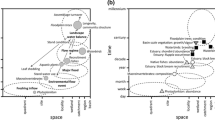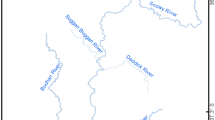Abstract
There have been significant diversions of water from rivers and streams around the world; natural flow regimes have been perturbed by dams, barriers and excessive extractions. Many aspects of the ecological ‘health’ of riverine systems have declined due to changes in water flows, which has stimulated the development of thinking about the maintenance and restoration of these systems, which we refer to as environmental flow methodologies (EFMs). Most existing EFMs cannot deliver information on the population viability of species because they: (1) use habitat suitability as a proxy for population status; (2) use historical time series (usually of short duration) to forecast future conditions and flow sequences; (3) cannot, or do not, handle extreme flow events associated with climate variability; and (4) assume process stationarity for flow sequences, which means the past sequences are treated as good indicators of the future. These assumptions undermine the capacity of EFMs to properly represent risks associated with different flow management options; assumption (4) is untenable given most climate-change predictions. We discuss these concerns and advocate the use of demographic modelling as a more appropriate tool for linking population dynamics to flow regime change. A ‘meta-species’ approach to demographic modelling is discussed as a useful step from habitat based models towards modelling strategies grounded in ecological theory when limited data are available on flow-demographic relationships. Data requirements of demographic models will undoubtedly expose gaps in existing knowledge, but, in so doing, will strengthen future efforts to link changes in river flows with their ecological consequences.


Similar content being viewed by others
References
Aarts BGW, Nienhuis PH (2003) Fish zonations and guilds as the basis for assessment of ecological integrity of large rivers. Hydrobiologia 500:157–178
Anderson KE, Paul AJ, McCauley E, Jackson LJ, Post JR, Nisbet RM (2006) Instream flow needs in streams and rivers: the importance of understanding ecological dynamics. Frontiers in Ecology and the Environment 4:309–318
Annear TC, Hubert W, Simpkins D, Hebdon L (2002) Behavioural and physiological response of trout to winter habitat in tailwaters in Wyoming, USA. Hydrological Processes 16:915–925
Archibald JD (1994) Metataxon concepts and assessing possible ancestry using phylogenetic systematics. Systematic Biology 43:27–40
Arthington AH, Pusey BJ (2003) Flow restoration and protection in Australian rivers. River Research and Applications 19:377–395
Arthington AH, Rall JL, Kennard MJ, Pusey BJ (2003) Environmental flow requirements of fish in lesotho rivers using the drift methodology. River Research and Applications 19:641–666
Arthington AH, Bunn SE, Poff NL, Naiman RJ (2006) The challenge of providing environmental flow rules to sustain river ecosystems. Ecological Applications 16:1311–1318
Ballinger A, Lake PS, Mac Nally R (2007) Do terrestrial invertebrates experience floodplains as landscape mosaics? immediate and longer-term effects of flooding on ant assemblages in a floodplain forest. Oecologia 152:227–238
Beissinger SR (1995) Modeling extinction in periodic environments—everglades water levels and snail kite population viability. Ecological Applications 5:618–631
Beissinger SR, Westphal MI (1998) On the use of demographic models of population viability in endangered species management. Journal of Wildlife Management 62:821–841
Biggs BJF, Nikora VI, Snelder TH (2005) Linking scales of flow variability to lotic ecosystem structure and function. River Research and Applications 21:283–298
Bond NR, Lake PS, Arthington AH (2008) The impacts of drought on freshwater ecosystems: an Australian perspective. Hydrobiologia 600:3–16
Brook BW, O’Grady JJ, Chapman AP, Burgman MA, Akcakaya HR, Frankham R (2000) Predictive accuracy of population viability analysis in conservation biology. Nature 404:385–387
Burgman MA (2000) Population viability analysis for bird conservation: prediction, heuristics, monitoring and psychology. Emu 100:347–353
Cai W, Cowan T (2008) Evidence of impacts from rising temperature on inflows to the Murray-Darling Basin. Geophysical Research Letters 35:L07701
Cai W, Cowan T, Raupach M (2009) Positive Indian Ocean Dipole events precondition southeast Australia bushfires. Geophysical Research Letters 36:L19710
Caswell H (2001) Matrix population models: construction analysis and Interpretation. Sinauer Associates Inc., Massachusetts
Dennis B, Ponciano JM, Lele SR, Taper ML, Staples DF (2006) Estimating density dependence, process noise, and observation error. Ecological Monographs 76:323–341
Doak DF, Morris W (1999) Detecting population-level consequences of ongoing environmental change without long-term monitoring. Ecology 80:1537–1551
Douglas MR, Brunner PC, Douglas ME (2003) Drought in an evolutionary context: molecular variability in Flannelmouth Sucker (Catostomus latipinnis) from the Colorado River Basin of western North America. Freshwater Biology 48:1254–1273
Dudgeon D et al (2006) Freshwater biodiversity: importance, threats, status and conservation challenges. Biological Reviews 81:163–182
Fieberg J, Ellner SP (2001) Stochastic matrix models for conservation and management: a comparative review of methods. Ecology Letters 4:244–266
Gippel CJ, Cosier M, Markar S, Liu CS (2009) Balancing environmental flows needs and water supply reliability. International Journal of Water Resources Development 25:331–353
Gleick PH (2003) Global freshwater resources: soft-path solutions for the 21st century. Science 302:1524–1528
Grafton Q (2010) How to increase the cost-effectiveness of water reform and environmental flows in the Murray-Darling Basin. Agenda 17:17–40
Gregory R, Ohlson D, Arvai J (2006) Deconstructing adaptive management: criteria for applications to environmental management. Ecological Applications 16:2411–2425
Growns I (2004) A numerical classification of reproductive guilds of the freshwater fishes of south-eastern Australia and their application to river management. Fisheries Management and Ecology 11:369–377
Guy CS, Brown ML (eds) (2007) Analysis and interpretation of freshwater fisheries data. American Fisheries Society, Bethesda
Hamstead M, Baldwin C, O’Keefe V (2008) Water allocation planning in Australia—current practices and lessons learned waterlines occasional paper No 6, April 2008 National Water Commission, Canberra
Hickey JT, Diaz GE (1999) From flow to fish to dollars: an integrated approach to water allocation. Journal of the American Water Resources Association 35:1053–1067
Hodgson DJ, Townley S (2004) Linking management changes to population dynamic responses: the transfer function of a projection matrix perturbation. Journal of Applied Ecology 41:1155–1161
Horne A, Stewardson M, Freebairn J, McMahon TA (2010) Using an economic framework to inform management of environmental entitlements. River Research and Applications 26:779–795
Humphries P, King AJ, Koehn JD (1999) Fish, flows and flood plains: links between freshwater fishes and their environment in the Murray-Darling River system, Australia. Environmental Biology of Fishes 56:129–151
Jones RN (2012) Detecting and attributing nonlinear anthropogenic regional warming in southeastern Australia. Journal of Geophysical Research D: Atmospheres 117
Jowett IG (1997) Instream flow methods: a comparison of approaches. Regulated Rivers-Research & Management 13:115–127
Jowett IG, Duncan MJ (1990) Flow variability in New-Zealand rivers and its relationship to in-stream habitat and biota. New Zealand Journal of Marine and Freshwater Research 24:305–317
King J, Brown C (2006) Environmental flows: striking the balance between development and resource protection. Ecology and Society 11:26
King J, Brown C, Sabet H (2005) A scenario-based holistic approach to environmental flow assessments for rivers. River Research and Applications 21:579
Kingsford RT (2009) Managing Australia’s scarce water resources for the environment. Pacific Conservation Biology 15:4–6
Lake PS (2000) Disturbance, patchiness, and diversity in streams. Journal of the North American Benthological Society 19:573–592
Lake PS (2003) Ecological effects of perturbation by drought in flowing waters. Freshwater Biology 48:1161–1172
Lake PS, Bond NR (2007) Australian futures: freshwater ecosystems and human water usage. Futures 39:288–305
Lancaster J, Downes BJ (2010) Linking the hydraulic world of individual organisms to ecological processes: putting ecology into ecohydraulics. River Research and Applications 26:385–403
Lande R, Engen S, Saether BE (2003) Stochastic population dynamics in ecology and conservation. Oxford University Press, Oxford
Landres PB, Morgan P, Swanson FJ (1999) Overview of the use of natural variability concepts in managing ecological systems. Ecological Applications 9:1179–1188
Lester RE, Webster IT, Fairweather PG, Young WJ (2011) Linking water-resource models to ecosystem-response models to guide water-resource planning—an example from the Murray—Darling Basin, Australia. Marine & Freshwater Research 62:279–289
Letcher BH, Nislow KH, Coombs JA, O’Donnell MJ, Dubreuil TL (2007) Population response to habitat fragmentation in a stream-dwelling brook trout Population. PLoS ONE 2(11):e1139
Lindenmayer DB, Likens GE (2009) Adaptive monitoring: a new paradigm for long-term research and monitoring. Trends in Ecology & Evolution 24:482–486
Lytle DA, Merritt DM (2004) Hydrologic regimes and riparian forests: A structured population model for cottonwood. Ecology 85:2493–2503
Lytle DA, Poff NL (2004) Adaptation to natural flow regimes. Trends in Ecology & Evolution 19:94–100
Mac Nally R (1983) On assessing the significance of interspecific competition to guild structure. Ecology 64:1646–1652
Mac Nally R, Fleishman E, Thomson J, Dobkin DS (2008) Use of guilds for modeling avian responses to vegetation change in the Intermountain West (USA). Global Ecology and Biogeography 17:758–769
Mac Nally R, Baker PJ, Cunningham SC, Horner GJ, Thomson JR (2011) Dynamics of Murray-Darling floodplain forests under multiple water stressors—the past, present and future of an Australian icon. Water Resources Research
Magalhaes MF, Beja P, Schlosser IJ, Collares-Pereira MJ (2007) Effects of multi-year droughts on fish assemblages of seasonally drying Mediterranean streams. Freshwater Biology 52:1494–1510
Marcot BG, Steventon JD, Sutherland GD, McCann RK (2006) Guidelines for developing and updating Bayesian belief networks applied to ecological modeling and conservation. Canadian Journal of Forest Research-Revue Canadienne De Recherche Forestiere 36:3063–3074
Merritt DM, Scott ML, Poff NL, Auble GT, Lytle DA (2010) Theory, methods and tools for determining environmental flows for riparian vegetation: riparian vegetation-flow response guilds. Freshwater Biology 55:206–225
Milly PCD, Wetherald RT, Dunne KA, Delworth TL (2002) Increasing risk of great floods in a changing climate. Nature 415:514–517
Milly PCD, Betancourt J, Falkenmark M, Hirsch RM, Kundzewicz ZW, Lettenmaier DP, Stouffer RJ (2008) Climate change—stationarity is dead: whither water management? Science 319:573–574
Milner NJ, Elliott JM, Armstrong JD, Gardiner R, Welton JS, Ladle M (2003) The natural control of salmon and trout populations in streams. Fisheries Research 62:111–125
Morris WF, Doak DF (2002) Quantitative conservation biology: theory and practice of population viability analysis. Sinauer Associates Inc., Massachusetts
Morris WF, Bloch PL, Hudgens BR, Moyle LC, Stinchcombe JR (2002) Population viability analysis in endangered species recovery plans: past use and future improvements. Ecological Applications 12:708–712
Noble RAA, Cowx IG, Goffaux D, Kestemont P (2007) Assessing the health of European rivers using functional ecological guilds of fish communities: standardising species classification and approaches to metric selection. Fisheries Management and Ecology 14:381–392
Palmer MA, Liermann CAR, Nilsson C, Florke M, Alcamo J, Lake PS, Bond N (2008) Climate change and the world’s river basins: anticipating management options. Frontiers in Ecology and the Environment 6:81–89
Parsons M, McLoughlin CA, Kotschy KA, Rogers KH, Rountree MW (2005) The effects of extreme floods on the biophysical heterogeneity of river landscapes. Frontiers in Ecology and the Environment 3:487–494
Petts GE (1996) Water allocation to protect river ecosystems. Regulated Rivers-Research & Management 12:353–365
Petts GE (2009) Instream flow science for sustainable river management. Journal of the American Water Resources Association 45:1071–1086
Poff NL, Zimmerman JKH (2010) Ecological responses to altered flow regimes: a literature review to inform the science and management of environmental flows. Freshwater Biology 55:194–205
Poff NL, Allan JD, Bain MB, Karr JR, Prestegaard KL, Richter BD, Sparks RE, Stromberg JC (1997) The natural flow regime. BioScience 47:769–784
Poff NL, Allan JD, Palmer MA, Hart DD, Richter BD, Arthington AH, Rogers KH, Meyers JL, Stanford JA (2003) Fiver flows and water wars: emerging science for environmental decision making. Frontiers in Ecology and the Environment 1:298–306
Resh VH, Brown AV, Covich AP, Gurtz ME, Li HW, Minshall GW, Reice SR, Sheldon AL, Wallace JB, Wissmar RC (1988) The role of disturbance in stream ecology. Journal of the North American Benthological Society 7:433–455
Richter BD, Baumgartner JV, Wigington R, Braun DP (1997) How much water does a river need? Freshwater Biology 37:231–249
Richter BD, Mathews R, Wigington R (2003) Ecologically sustainable water management: managing river flows for ecological integrity. Ecological Applications 13:206–224
Root RB (1967) Niche exploitation pattern of blue-gray gnatcatcher. Ecological Monographs 37:317
Saintilan NOI (2010) Ecosystem response modelling in the murray-darling basin. CSIRO, Australia
Sakaris PC, Irwin ER (2010) Tuning stochastic matrix models with hydrologic data to predict the population dynamics of a riverine fish. Ecological Applications 20:483–496
Schlosser IJ, Angermeier PL (1995) Spatial variation in demographic processes of lotic fishes: conceptual models, empirical evidence, and implications for conservation. Evolution and the Aquatic Ecosystem: Defining Unique Units in Population Conservation 17:392–401
Schodelbauerova I, Tremblay RL, Kindlmann P (2010) Prediction vs. reality: can a PVA model predict population persistence 13 years later? Biodiversity and Conservation 19:637–650
Shenton W, Hart BT, Brodie J (2010) A Bayesian network model linking nutrient management actions in the Tully catchment (northern Queensland) with Great Barrier Reef condition. Marine & Freshwater Research 61:587–595
Simons M, Podger G, Cooke R (1996) IQQM—a hydrologic modelling tool for water resource and salinity management. Environmental Software 11:185–192
Smith M, Caswell H, Mettler-Cherry P (2005) Stochastic flood and precipitation regimes and the population dynamics of a threatened floodplain plant. Ecological Applications 15:1036–1052
Stewardson MJ, Gippel CJ (2003) Incorporating flow variability into environmental flow regimes using the flow events method. River Research and Applications 19:459–472
Tennant WA, Bitterman ME (1975) Blocking and overshadowing in 2 species of fish. Journal of Experimental Psychology 104:22–29
Tharme RE (2003) A global perspective on environmental flow assessment: emerging trends in the development and application of environmental flow methodologies for rivers. River Research and Applications 19:397–441
Tibby J, Tiller D (2007) Climate-water quality relationships in three Western Victorian (Australia) lakes 1984–2000. Hydrobiologia 591:219–234
Todd CR, Ryan T, Nicol SJ, Bearlin AR (2005) The impact of cold water releases on the critical period of post-spawning survival and its implications for Murray cod (Maccullochella peelii peelii): a case study of the Mitta Mitta River, southeastern Australia. River Research and Applications 21:1035–1052
Van Winkle W, Rose KA, Winemiller KO, DeAngelis DL, Christensen SW, Otto RG, Shuter BJ (1993) Linking life history theory, environmental setting, and individual-based modeling to compare responses of different fish species to environmental change. Transactions of the American Fisheries Society 122:459–466
Vesk PA, Dorrough JW (2006) Getting trees on farms the easy way? lessons from a model of eucalypt regeneration on pastures. Australian Journal of Botany 54:509–519
Vogel RM, Fennessey NM (1995) Flow duration curves.2. A review of applications in water-resources planning. Water Resources Bulletin 31:1029–1039
Vörösmarty CJ, Green P, Salisbury J, Lammers RB (2000) Global water resources: vulnerability from climate change and population growth. Science 289:284–288
Vörösmarty CJ et al (2010) Global threats to human water security and river biodiversity. Nature 467:555–561
Welcomme RL, Winemiller KO, Cowx IG (2006) Fish environmental guilds as a tool for assessment of ecological condition of rivers. River Research and Applications 22:377–396
Winemiller KO, Rose KA (1992) Patterns off life-history diversification in North American fishes: implications for population regulation. Canadian Journal of Fisheries and Aquatic Sciences 49:2196–2218
Xu CL, Letcher BH, Nislow KH (2010) Size-dependent survival of brook trout Salvelinus fontinalis in summer: effects of water temperature and stream flow. Journal of Fish Biology 76:2342–2369
Yen J, Shenton W, Bond NR, Spring DA, Mac Nally R (in review) Identifying robust water-management strategies in variable climates: a Bayesian demographic modelling approach
Acknowledgments
The (Australian) National Water Commission and the Victorian Water Trust funded the work undertaken in the paper through the project: Farms, Rivers and Markets: A Whole-of-System Approach for Doing More with Less Water, funding for which was obtained largely due to the leadership of John Langford. Assistance was rendered to us by the ‘ecology team’ of that project, which included Andrew Western, Ben Gawne, Mike Stewardson, Darren Neilson, Nathan Ning, and Geoff Vietz. Additional support came from a grant from the Australian Research Council, DP120100797. We also thank Sam Lake, Paul Reich, Jim Thomson and Shaun Cunningham for helpful insights into the work. This is contribution No. 246 from the Australian Centre for Biodiversity, Monash University.
Author information
Authors and Affiliations
Corresponding author
Rights and permissions
About this article
Cite this article
Shenton, W., Bond, N.R., Yen, J.D.L. et al. Putting the “Ecology” into Environmental Flows: Ecological Dynamics and Demographic Modelling. Environmental Management 50, 1–10 (2012). https://doi.org/10.1007/s00267-012-9864-z
Received:
Accepted:
Published:
Issue Date:
DOI: https://doi.org/10.1007/s00267-012-9864-z




